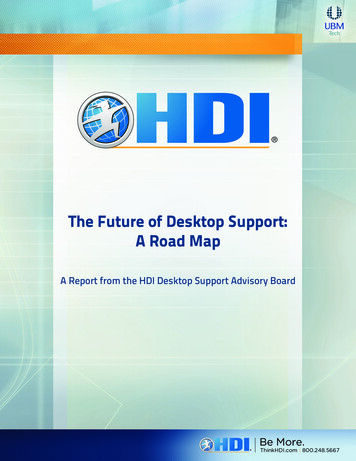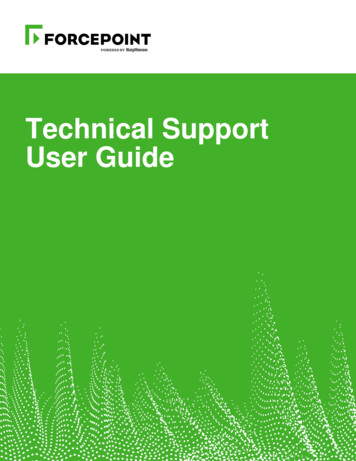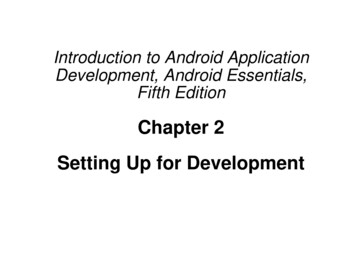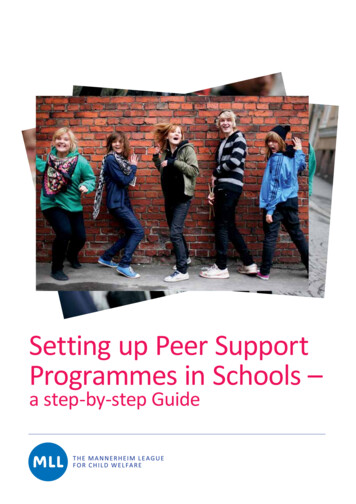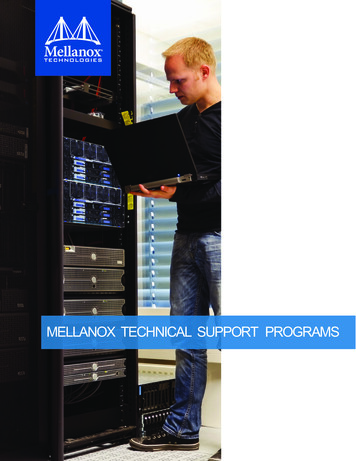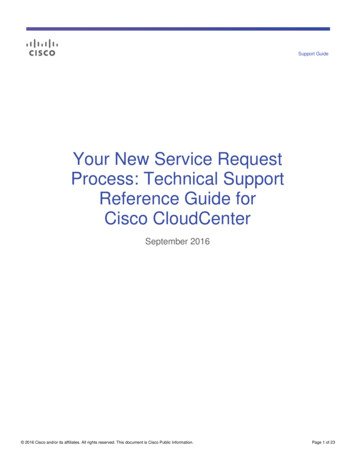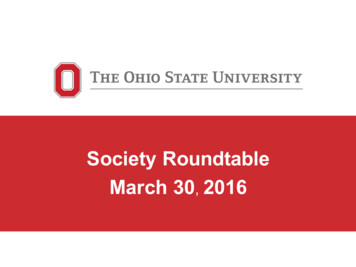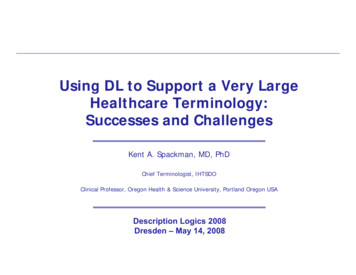
Transcription
Using DL to Support a Very LargeHealthcare Terminology:Successes and ChallengesKent A. Spackman, MD, PhDChief Terminologist, IHTSDOClinical Professor, Oregon Health & Science University, Portland Oregon USADescription Logics 2008Dresden – May 14, 2008
About me Current:– Chief Terminologist for IHTSDO– Clinical Professor of Pathology & Medical Informatics, OregonHealth & Science University, Portland, Oregon, USA Background primarily in academic medicalinformatics, and clinical pathology– MD – Canada. Primary care training.– PhD in CS, machine learning, U of Illinois at UrbanaChampaign– Specialty training and (former) practice inhematopathology, blood banking, transfusion medicine &coagulation 1997-2007 Scientific Director of SNOMED, for the Collegeof American Pathologists
About SNOMED CT Name:– Systematized Nomenclature of Medicine - ClinicalTerms Description:– A work of clinical terminology Main purpose:– Coded representation of meanings used in healthinformation
About IHTSDO International Health TerminologyStandards Development Organization Formed in Denmark, 23rd March 2007– Just over a year old Area of standardization:– Terminology for interoperability of electronichealth information14/05/20084
The purpose of the IHTSDO To acquire, own and administer the rights toSNOMED CT and other relevant assets(collectively, the "Terminology Products");To develop, maintain, promote and enable theuptake and correct use of its TerminologyProducts around the world;To undertake activities required to achieve thesepurposes14/05/20085
Status of the IHTSDO The IHTSDO is a Danish Association The Association is a registered not-for-profitentity in Denmark [23rd March 2007] Articles of Association detail thewho, what, where and how of the Association– http://www.ihtsdo.org/about-us/governance/ The Association owns the intellectual property Intellectual property in SNOMED CT andantecedent works (SNOMED 3.5, RT etc.)transferred to the IHTSDO [26th April 2007]14/05/20086
Status of the IHTSDO Members are countries– Eligible Members are all voting members ofthe United Nations The Members control the organization and theArticles of Association; [subject to Danish Law] Nine Charter [initial] Members:Australia, Canada, Denmark, Lithuania, Netherlands, New Zealand, Sweden, UnitedKingdom, United States of America14/05/20087
Status of the IHTSDO Physical office in the IT University in Copenhagen– Web site www.ihtsdo.org Three year support contract with the College ofAmerican Pathologists [First IHTSDO Release July2007] New roles within the IHTSDO [at outset interim];recruiting permanent posts At outset:––––14/05/2008Chief Executive Officer [Ulrich Andersen]Chief Terminologist [Kent Spackman]Chief Quality Officer [Ed Cheetham]Small number of administrative staff8
What’s different now? Articles of association 2.3 Principles– 2.3.1 The Association will seek to govern itselfand conduct all of its activities in accordance withprinciples of openness, fairness, transparency andaccountability to its Members.14/05/20089
What’s different now? Open collaborative working For access to IHTSDO committeedocuments, work groups, project groups anddiscussion forums:– Send email to support@ihtsdo.org14/05/200810
What’s different now? The Association’s work is funded by annualMembership fees paid by the Member nations– “Fair share” is determined by World Bank GNIAtlas Use in Member territories does not carry an IHTSDOfee Use in non-Member territories comes under a singleworld-wide license (called an “affiliate license”)[more on licensing later] SNOMED CT is much more available (no fees forevaluation or for qualifying research projects)14/05/200811
What’s different now? Genuine and increased intensity of efforts tocooperate and harmonize with otherstandards bodies Active discussions are ongoing with:– HL7, LOINC, IUPAC, WHO, WONCA Other contacts have been made or are plannedbetween IHTSDO and:– CEN, ISO, IHE, openEHR, RadLex, & others14/05/200812
What’s different now? Role of the College of American Pathologists– Support Organization, by contract (3 years)– Perform maintenance and release– NO governance responsibility– Name change to reflect changed role and status SNOMED Terminology Solutions (CAP STS)14/05/200813
IHTSDO Model: Organizational RelationshipsInternational release available to all MemberNationsCooperation between & among countriesPrinciples eNationalReleaseCentreLocal/NationalHealth Entities
IHTSDO Organizational StructureGENERAL ASSEMBLYHarmonizationBoardsManagement BoardAffiliate ForumContentCommitteeTechnicalCommitteeResearch 05/200815
Governance Each Member Country appoints a representative tothe General Assembly The General Assembly governs the Association (theSDO). Members of the Management Board (MB) areelected by the General Assembly (GA) Number of MB Directors is from 3 to 12 (GAdetermines)– Currently nine (one from each Charter Member)14/05/200816
Committees Four Standing Committees––––ContentTechnicalResearch & InnovationQuality assurance Committee members are elected by the GeneralAssembly Worthy of note that Members have nominated andindividuals have been elected from outside Memberjurisdictions– E.g.: Stefan Schulz – Content Committee Committee meetings are also open to the public (butonly elected committee members have a blanket right toparticipate)14/05/200817
Working Groups Two types of Working Group [both are entirely open]– Special Interest Group (SIG): [Domain focused e.g. profession(nursing), specialism (mapping)]– Project Group: [Task focused] First Global Profession SIG for Pathology and Laboratory MedicineSeptember [Special thanks to World Association of Societies ofPathology and Laboratory Medicine]14/05/200818
Special Interest Groups Open working group meetings on-line discussion forumsActive Special Interest Groups (SIGs):– Concept model SIG– Mapping SIG– Content-area focused SIGs Pharmacy Primary care Nursing Anesthesiology Pathology and Laboratory Medicine
Affiliates What is an “affiliate”?– Anyone other than a member nation who has a license (the“Affiliate License”) for use of IHTSDO Terminology Products What is the affiliate license?– The single world-wide license for use of SNOMED CT /14/05/200820
Licensing of SNOMED CT Single form of end-user license (Affiliate License)SNOMED CT is made much more availableNo charge for research purposesPermits world-wide use of SNOMED CTAffiliate licensees pay:– NO fees to IHTSDO for use in any Member nation. Allobligations are met by the Member through their IHTSDOmembership agreement. Cost-recovery is permitted– Charges as set by the IHTSDO for use in non-membernations (for implementation in clinical record systems)14/05/200821
Harmonization Boards – Recent Efforts HL7– Positive discussions, Aug. in Brisbane, Sept. in Atlanta– Discussions propose joint endorsement of Terminfo work product as astandardWHO– Positive discussions, August 2007 Brisbane– Milestones and high level work proceeding– Goal to have a joint harmonization board begin in February 2008LOINC– Positive discussions Sept Atlanta & after– Detailed preparatory work proceeding; no milestones yet agreedIUPAC– Detailed preparatory work – October 2007WONCA14/05/200822
Brief history of the terminologies that went intoSNOMED CT SNOMED– developed by the College of American Pathologists (esp.Roger Côté of the University ofSherbrooke, Quebec, Canada)– 1979: SNOMED 2, widely adopted by surgical pathologydepartments worldwide– 1993: SNOMED 3, expanded and enhanced, but not widelyadopted. Changed meanings of codes from prior version. Read Codes– Developed by James Read, a GP in UK.– 1993: Read v2 Adopted by UK NHS for GP electronic records– 1992 to 1999: Clinical Terms projects, resulted in ClinicalTerms version 3 (CTV3). Greatly expanded andenhanced, but not widely adopted.
Brief History - continued 1996 to 2000:– CAP and Kaiser Permanente (KP) jointly worked to expandand revise SNOMED 3 to produce SNOMED ReferenceTerminology (RT) – the first version to be based on a DLfoundation 1999 to 2002:– UK NHS and CAP, along with KP, jointly worked to mergeCTV3 and SNOMED RT
Source of Concepts in SNOMED CT (2002)
Purpose of the Terminology To represent health information– Recorded by clinicians– At the level of detail they prefer Not forced into arbitrary categories– In coordination with a known information model To retrieve and analyze health information– According to its meaning, not merely its surfaceform– To enable Decision support for individual cases Population-based aggregation and analysis
Are there SNOMED implementations? There is no such thing as a SNOMEDImplementation, but There are implementations of electronichealth record systems that utilize SNOMEDCT
Decision support Central to the Value of Semantic Interoperability– Numerous studies document the ability of computerizeddecision support to decrease costs and improve quality– But use is limited– One major barrier is lack of standardization– Clinical terminology standards help fill this need but we aren’t there yet
Terminology enables decision support:influenza vaccination decision support program criterion:– chronic cardio respiratory disorders patient record:– mild persistent asthma
Terminology enables decision support:hemoglobin A1C interpretation decision support program asks for:– hereditary anemia due to disturbance of hemoglobinsynthesis patient record says:– Aγ β HPFH and β0 thalassemia in cis
Terminology enables decision support:antibiotic therapy decision support program asks for:– bacterial effusions patient record says:– tuberculous ascites
State of the art? Currently implemented systems are a long way fromstandardized delivery of semantic interoperability ofclinical data
What’s the problem? No single barrier– Inertia of existing systems– Cost of change & lack of clear return forinvestments in change– Barriers due to questions about standards: Choice of different standards for same purpose Inadequate coordination between those with differentpurposes (e.g. terminology vs. information model) Quality, reliability, and implementability
Categories of Standards to SupportInteroperability Data exchange / messagingTerminology standardsDocument standardsInformation Model / EHR standards– Architecture standards– Application standards
What SNOMED is not: SNOMED is not an attempt to– standardize the language of health care providers– get everyone to speak the same language “We are not the language police” Language is very changeable, fluid, and contextladen Clinicians (and people in general) determine whatwords mean by how they use them. SNOMED attempts to properly reflect the meaningsgiven to words and phrases by people
What SNOMED is not: SNOMED is not an attempt to independently createstandard meanings for health professions orscientists– It follows existing published standards– It seeks to encourage scientific and professional groups tocome to consensus and publish standards For example:– ISBT (International Society of Blood Transfusion) publishesterminology for Human Red Blood Cell Surface Antigens.– SNOMED CT attempts to properly reflect and integrate thestandard terminology so that it is usable with all others
What SNOMED is not: SNOMED is not a complete knowledge base– It represents terminological knowledge only Definitional, always necessarily true of each instance– It does not represent assertional knowledge Uncertain, variable from case to case Example: Appendicitis– Terminological knowledge: Inflammation located in the appendix– Assertional knowledge: associated with anorexia, nausea, abdominal paininitially central but moving to RLQ, rebound tendernessover McBurney’s point, and increased WBC
Building blocks Concepts– The anchors for meaning Descriptions– Terms (strings of readable characters) used toexpress the meanings of the concepts in humanlanguage Relationships– Concept-to-concept links used to expressinformation in computer-processable language First purpose: formal logical meanings Other purposes: tracking retired concepts, representing“facts” that may vary, and supporting post-coordinationby suggesting valid qualifiers
Types of concepts (classes)Current 19 top levels of hierarchies (January 2008 release): situation with explicitcontext clinical finding procedure body structure observable entity organism substance pharmaceutical / biologicproduct physical object physical force event environment orgeographical location social context specimen record artifact stage or scale linkage concept qualifier value special concept
Fully Specified Name (FSN) Each concept has a name that has no acronyms and nohidden context Example:CT angiographyFSN angiography by computed tomography with contrast (procedure) The word in parens at the end is called the “FSN tag”
Types of concepts – by FSN tagCurrent 41 FSN tags (January 2008 release):TAG NAME :disorderprocedurefindingorganismbody structuresubstanceproductqualifier valueobservable entityphysical objectmorphologic ttributeenvironmentspecimenassessment scalecell# 48543034161357533002949112611091052884609TAG NAME:geographic locationcell structurepersonnavigational conceptethnic grouptumor stagingrecord artifactphysical forcereligion/philosophynamespace conceptadministrative conceptsocial conceptlife styleracial groupstaging scalelink assertioninactive conceptenvironment / locationlinkage conceptspecial conceptSNOMED RT CTV3# 1
ActiveconceptsJan 2008ReleaseBy FSN Tag
Largest Hierarchies Clinical finding / disorder Procedure / regime / therapy
Most important “value” hierarchies Body structure, cell structure, cellMorphologic abnormalityQualifier valuesSubstancesObservablesOrganisms
observablesMost importanthierarchies based onnumber of definingrelationships thatuse them as valuesanatomysubstancesmorphologyqualifiervalues
Successes Collaborative process for editingConversion of SNOMED 3 to a DL foundationMerger with CTV3 without losing DL foundationMaintenance of the hierarchiesNormal formsRole grouping (as a compromise)Introduction of role hierarchies
Successes Collaborative process for editingConversion of SNOMED 3 to a DL foundationMerger with CTV3 without losing DL foundationMaintenance of the hierarchiesNormal formsRole grouping (as a compromise)Introduction of role hierarchies
Collaborative Development Fundamental to the initial work on SNOMED RTundertaken by Kaiser Permanente and C.A.P.
Content Development Tools (1998) Ontyx TDE (Ontylog classifier)– Classifies with first-order logic subset– Generates change sets for all changes Metaphrase Finder (Lexical Technologies Inc)– Lexical Closure, Suggested Relationships– Generates change sets for all changes Galapagos Configuration Tools (KP – Campbell)– Configuration control and conflict identification– Interactively resolve conflicts
CMT Development CycleStep 1:Acquire CMTStep 4:Identify andresolve conflictsStep 2:Enhance CMTStep 3:Return changes
Ontyx Editor
CMT Development CycleStep 1:Acquire CMTStep 4:Identify andresolve conflictsStep 2:Enhance CMTStep 3:Return changes
Metaphrase Suggestions
CMT Development CycleStep 1:Acquire CMTStep 4:Identify andresolve conflictsStep 2:Enhance CMTStep 3:Return changes
Conflict Resolution
CMT Development CycleStep 1:Acquire CMTStep 4:Identify andresolve conflictsStep 2:Enhance CMTStep 3:Return changes
Configuration Management Change-Set Configuration Management– Supports distributed, concurrent change– Provides the foundation for metrics and reproducible,measurable development processes
URU Criteria1. Definitions should be Understandable by averageclinicians, given brief explanations2. We assess understandability by examiningReproducibility3. We can ignore distinctions for which we see no Usein health care
Evolutionary Design Evolution without pre-ordained design Accumulation of desirable features Heterogeneity of perspectives Dealing with Scale– Participatory consensus-based approach Involve the experts– Semantics-based concurrency control Description logic foundation– Configuration management tools Keith Campbell’s “Galapagos” tool set
Successes Collaborative process for editingConversion of SNOMED 3 to a DL foundationMerger with CTV3 without losing DL foundationMaintenance of the hierarchiesNormal formsRole grouping (as a compromise)Introduction of role hierarchies
About SNOMED’s use of DLSNOMEDversionConcept & RoleRoleforming Operators axiomsLanguageRolegroupingEarly work(1996-1999)( , R:C)( )ELNoSNOMED RT(2000-2001)( , R:C)( )EL No( , R:C)( )ELYesELH YesSNOMED CT(Jan02-Jan04)SNOMED CT ( , R:C)( )(Jul04-present)R SNotation mostly follows Donini in Ch.3 Description Logic Handbook( ) means right identities were used
Table 3: Number of immediate is-a relationships changed by algorithmic subsumption calculationsUsing DL for the SNOMED RT hierarchy (2000)P axisD axis Others TotalStated isa rels.4,214 15,838removedInferredis-a rels. 15,094 10,557added390 20,442217 25,868Number of immediate is-a relationships changedby algorithmic subsumption calculationsTransitive reduction removed many is-a relationships from theD axis because of modeling style
Right identity(restricted role value maps) R S R xRy ٿ ySz xRz femurFracture v site.femur headOfFemurFracture v site.headOfFemur headOfFemur v part-of.Femur Allows the automated inference that:– headOfFemurFracture v FemurFracture But this isn’t the purpose for which we use right identity in the currentrelease !
Right identity(restricted role value maps) R S R xRy ٿ ySz xRz allergyToAspirin v causativeAgent.aspirinSubstance aspirinProduct v hasActiveIngredient.aspirinSubstance allergyToAspirinProduct v causativeAgent.aspirinProduct Allows the automated inference that:– allergyToAspirinProduct v allergyToAspirin
Successes Collaborative process for editingConversion of SNOMED 3 to a DL foundationMerger with CTV3 without losing DL foundationMaintenance of the hierarchiesNormal formsRole grouping (as a compromise)Introduction of role hierarchies
Pressure to Abandon Strict DL Semantics CTV3 was designed to allow navigation by clinicians Arbitrary navigation concepts were allowed– “Drugs A-F”, “Drugs G-S”, “Drugs T-Z” Concerns about how natural to a clinician thehierarchies would look Concerns that consistent models were not possible(every doctor is Humpty Dumpty “a word meanswhatever I choose it to mean”)
Navigation ExampleHow a GP might like tonavigate to Influenza Avirus from “virus”:It is six levels deep if you try tonavigate the is-a hiearchy:VirusVirusInfluenza A virusRNA virusEnveloped ssRNA virus without a DNA step in life-cycleEnveloped ssRNA virus without a DNA step with multiplestranded negative-sense genomeFamily OrthomyxoviridaeGenus Influenzavirus AInfluenza A virus68
Solution Separate “reference properties” and “interfaceproperties” of the terminology Navigation to find a term is an interface property Preferred term selection is an interface property Correct definition of meaning is a “referenceproperty”
Avoiding Right Identities by Using SEP TripletsLiver StructureXM0Ps Liver structureT-62000 LiverLiver PartT-D0535 Liver partLobe of liverEntire liver7N330 Liver
Successes Collaborative process for editingConversion of SNOMED 3 to a DL foundationMerger with CTV3 without losing DL foundationMaintenance of the hierarchiesNormal formsRole grouping (as a compromise)Introduction of role hierarchies
New Content AdditionsNumber of New Active Concepts per an08
Concept Model ChangeNumber of Attributes withDefining Relationships605550454035Jan Jul Jan Jul Jan Jul Jan Jul Jan Jul Jan Jul Jan02 02 03 03 04 04 05 05 06 06 07 07 08
Percentage of SNOMED CT concept codes thatare “sufficiently Jan 02 Jul 02 Jan 03 Jul 03 Jan 04 Jul 04 Jan 05 Jul 05 Jan 06 Jul 06 Jan 07 Jul 07 Jan 08Eventually should reach 70% or more of disorders, findings & procedures
Successes Collaborative process for editingConversion of SNOMED 3 to a DL foundationMerger with CTV3 without losing DL foundationMaintenance of the hierarchiesNormal formsRole grouping (as a compromise)Introduction of role hierarchies
Definition of Normal Forms In original RT work, dual independent modelingrequired exact agreement on stated definition– Resulted in unresolved arguments about modeling style State most immediate parent concepts only, and only thoserelationships that have changed, or State proximal primitives only, and all defining relationships Defining a normal form allowed different modelingstyles for different purposes or preferencesSpackman KA. Normal forms for description logic expression of clinical concepts in SNOMED RT.Proceedings/AMIA Annual Symposium. :627-631, 2001.
Successes Collaborative process for editingConversion of SNOMED 3 to a DL foundationMerger with CTV3 without losing DL foundationMaintenance of the hierarchiesNormal formsRole grouping (as a compromise)Introduction of role hierarchies
Role Grouping as a Compromise Implementers and modelers fear/loathe nesting ofexpressions– Nesting violates simple flat frame-based model Reality demands faithful representation Role grouping attempted (with partial success) tohide the complexity– But it was misunderstood by some in DL community asbeing a proprietary hackSpackman KA, Dionne R, Mays E, Weis J. Role grouping as an extension to the description logic of Ontylogmotivated by concept modeling in SNOMED. Proceedings/AMIA Annual Symposium. :712-716, 2002.
Need for Role Groups When a single concept may have more than one value for aparticular attribute– for example, “bone fusion with tendon transfer” method fusion, site bone, and method transfer, site tendon And, one attribute-value pair needs to be associated withanother.– How can we specify that the fusion is done to the bone andnot to the tendon? and that the transfer is done to thetendon and not to the bone?
Role Groups as a Solution Informally:– don’t nest or create sub procedures– simply “group” the attribute-value pairs Using curly braces as a syntactic marker:{ site bone, method fusion},{site tendon, method transfer} Or, in tabular form, use a “group” column:attrvaluegroupsitebone1method fusion1sitetendon2method transfer 2
Role Grouping Logical Form:A Nested Existential Restriction C RRG .( R1.C1 R2.C2) RRG.( R3.C3 ) Distributed as three 4-tuples in relationships table:C R3 C3 0C R1 C1 1C R2 C2 1– Role group numbers are arbitrary integers, and not designed to bestable across changes in the concept definition
Successes Collaborative process for editingConversion of SNOMED 3 to a DL foundationMerger with CTV3 without losing DL foundationMaintenance of the hierarchiesNormal formsRole grouping (as a compromise)Introduction of role hierarchies
Role (attribute) hierarchies Selected SNOMED CT attributes have a hierarchicalrelationship to one another known as “rolehierarchies.” In a role hierarchy, one generalattribute is the parent of one or more specificsubtypes of that attribute. Concepts defined usingthe more general attribute can inherit conceptsmodeled with the more specific subtypes of thatattribute.
Role hierarchies – procedures PROCEDURE DEVICE––––DIRECT DEVICEINDIRECT DEVICEUSING DEVICEUSING ACCESS DEVICE PROCEDURE MORPHOLOGY– DIRECT MORPHOLOGY– INDIRECT MORPHOLOGY PROCEDURE SITE– PROCEDURE SITE - DIRECT– PROCEDURE SITE - INDIRECT
Role hierarchies – clinical findings ASSOCIATED WITH role hierarchy: ASSOCIATED WITH– AFTER– DUE TO– CAUSATIVE AGENT
Challenges & New Directions Quality assurance– Finding errors Model errors Individual concepts– Correcting errors– Maintaining correctness Tooling for editing and collaborative work Education of clinician and scientist editors Technical challenges– Migrating to greater expressiveness Balancing expressivity and classifier complexity– Specific issues of implementation Post-coordination, crossovers
Challenges & New Directions Quality assurance– Finding errors Model errors Individual concepts– Correcting errors– Maintaining correctness Tooling for editing and collaborative work Education of clinician and scientist editors Technical challenges– Migrating to greater expressiveness Balancing expressivity and classifier complexity– Specific issues of implementation Post-coordination, crossovers
Transitive Closure Stability1.00Remaining valid is-a's from each 78subsequent release sequenceR3R9R4R10R5R11910R611
Retiring Erroneous ContentIdentified and Retired Per 04002000Jul Jan Jul Jan Jul Jan Jul Jan Jul Jan Jul Jan02 03 03 04 04 05 05 06 06 07 07 08
Challenges & New Directions Quality assurance– Finding errors Model errors Individual concepts– Correcting errors– Maintaining correctness Tooling for editing and collaborative work Education of clinician and scientist editors Technical challenges– Migrating to greater expressiveness Balancing expressivity and classifier complexity– Specific issues of implementation Post-coordination, crossovers
Tools Much better tools are needed to support– Collaborative editing– Conflict resolution– Quality assurance and auditing A possible platform for open-source developments:– OHT (Open Health Tools) www.openhealthtools.org
Challenges & New Directions Quality assurance– Finding errors Model errors Individual concepts– Correcting errors– Maintaining correctness Tooling for editing and collaborative work Education of clinician and scientist editors Technical challenges– Migrating to greater expressiveness Balancing expressivity and classifier complexity– Specific issues of implementation Post-coordination, crossovers
Concept & role forming operators& terminological axiomsName of constructPrimitive conceptPrimitive roleTopBottomConjunctionExists restrictionDisjunctionNegationValue restrictionRole compositionRestricted role value mapsConcept definitionPrimitive conceptintroductionPrimitive role introduction(role hierarchy)NotationAR CuD R.CCtD C R.CR1 RnR SvRR SvSR SvTA CAvCSemanticsAI IRI I I I CI DI{x y.RI(x,y) CI(y)}CI DI I\CI{x y.RI(x,y) CI(y)}RI1 RInxRy ySz xRzxRy ySz xSzxRy ySz xTzAI CIAI CIRvSRI SI
Should we add more expressive DL features? General concept inclusion axiomsTransitive rolesReflexive rolesDisjointness axiomsValue restrictionsNegationDisjunctionCyclic definitionsNumber restrictions
General concept inclusion axioms Extremely useful feature Compatible with a polynomial-time structuralsubsumption algorithm Allows us to say what is true in addition to what issufficient– Gastric ulcer is located in the stomach, and in addition itnecessarily involves the gastric mucosa
Transitive roles xRyyRz xRz Useful for causal/associational chains Interaction with role hierarchy is interesting & useful Example: Associated-with-after– Varicella (chicken pox)– An infection with causative-agent varicella virus– Herpes zoster– Also has causative-agent varicella virus, and occurs aftervaricella– Post-herpetic neuralgia– Occurs after herpes zoster (therefore occurs after varicella), but isnot an infection with causative-agent varicella virus
Reflexive roles Plan to introduce reflexive “part-of” as a way ofhandling “SEP” model evolutionproper-part-of v part-of² v part-ofS part-of . EP proper-part-of . ESuntisrivaraporn B, Baader F, Schulz S, and Spackman K. Replacing SEP-Triplets in SNOMED CT using Tractable DescriptionLogic Operators. In Jim Hunter Riccardo Bellazzi, Ameen Abu-Hanna, editor, Proceedings of the 11th Conference on ArtificialIntelligence in Medicine (AIME'07), Lecture Notes in Computer Science. Springer-Verlag, 287-291, 2007.
Value restriction R.C Not an intuitive construct– person u hasCar.Jaguar– Includes people who have no car, but if they had one itwould have to be a Jaguar . . . . Do we encounter this kindof concept in common-sense thinking? Creates pernicious interactions with disjunction and negationthat tend to make structural subsumption algorithmsincomplete But it was included in ALC and FL , so languages including itwere studied extensively.
Negation C Head injury without loss of consciousnessheadInjury u lossOfConsciousnesssituation u includes.headinjury u includes.lossOfConsciousness
Disjunction C t D Some high-level aggregators are naturallydisjunctive We can address this need partially by usingnavigation hierarchies
Cyclic definitions, number restrictions ? No significant need for these at present
International Health Terminology Standards Development Organization Formed in Denmark, 23. rd. March 2007 - Just over a year old Area of standardization: - Terminology for interoperability of electronic health information. 14/05/2008. 4
